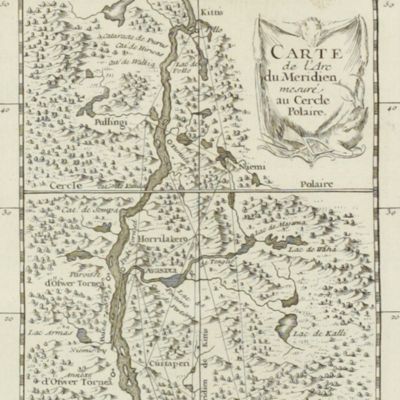Maupertuis, P.L. Moreau de
Sur la Figure de la Terre déterminée par Messieurs de l'Académie royale des Sciences, qui ont mesuré le degré du méridien au Cercle Polaire.
Paris, l'Imprimérie Royale, 1740. 4to (25.8 x 20.2 cm). pp. 90-96; 389-469 In: Histoire de l'Académie royale des Sciences Année MDCCCXXXVII. Engraved allegorical frontispiece; title page; [vi], 120, 492 pp.; engraved map of Lapponia; five engraved, folded plates. Contemporary full polished calf. Boards with double gilt borders; spine with five raised bands, gilt floral patterns and two red morocco labels with gilt title. Gilt floral inner dentelles. Marbled endpapers. Mottled edges.
The first accurate measuring of the shape of the Earth, by the French mathematician, astronomist, philosopher, and director of the Académie des Sciences, Pierre Louis Moreau de Maupertuis (1698-1759). The results of Maupertuis’s researches were first communicated at the Academy during a public meeting “Discours qui a été lû dans l'assemblée publique du 13 Novembre 1737”, but not put into print in the academy’s Histoire until the next year, in a small octavo booklet. “In the 1730s, the shape of the Earth became a flashpoint in the battle among rival systems of mechanics. Maupertuis, based on his exposition of Newton (with the help of his mentor Johan Bernoulli) predicted that the Earth should be oblate, while his rival Jacques Cassini measured it astronomically to be prolate. In 1736 Maupertuis acted as chief of the French Geodesic Mission sent by King Louis XV to Lapland to measure the length of a degree of arc of the meridian. His results ... essentially settled the controversy in his favour” (Wikipedia). This is the first quarto edition, in which Maupertius starts with a narrative of the voyage through Lapponia and ends with the proof of his theory, excluding, for example, additional stellar and solar observations made in Paris as they were not essential for reaching his conclusions, except for a Table des Accélérations de la Pendule; & des Allongements du pendule; depuis l'Équateur jusqu'au Pole. The first quarto edition, being the academy’s complete Histoire volume for 1737, contains several other papers, e.g. by Cassini, Du Hamel and Buffon, and Reamur. Perhaps the most important other contribution, however, is by the French philosopher and astronomer Alexis Claude de Clairaut (or Clairault) (1713-1765) De l'Aberration apparente des étoiles, caussée par le mouvement progressif de la Lumière (pp. 205-227; 11 engraved figures on two folding plates). Clairaut who travelled with Maupertius to Lapponia, here published the first paper on the parallax of ‘fixed’ stars. The Histoire volumes were often published with some delay, and - subsequently - often reprinted, but of the one for 1737 this is the first edition. Provenance: 1824 circular pictorial bookplate of the Bath Literary Institution mounted on the front pastedown, together with a shelf label of the same. Board edges and spine worn; binding weak; otherwise (internally) in very good condition; clean, unmarked. Norman, 1458.




